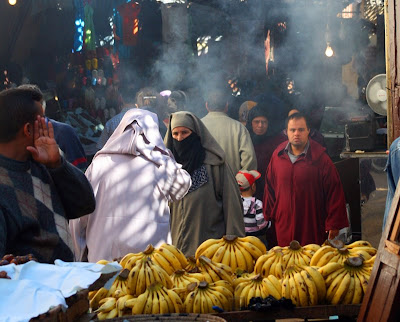
Henna is used in Morocco to dye the skin in intricate patterns, sometimes called temporary tattoos. Henna is an integral part of many celebrations in Morocco and it is quite common to see henna on women's hands and feet for weddings and special occasions. Although the use of henna at weddings is well known, it is also commonly used with the ceremonies for Id al-Adha and male circumcision.
The anthropologist, Catherine Cartwright-Jones, points out that "
the designs are often variants on the traditional North African "Khamsa” pattern: a cross with four dots surrounding; a square, circle or diamond shape with one dot within and four surrounding; hand shapes, and variations on these. People applied henna and the “Khamsa” patterns to avert the “Evil Eye”.
For visitors it is a popular experience to have henna applied, particularly for women.
It is also possible to buy henna patterns so that you can apply henna once you return home. The best place to buy henna and henna patterns is in the Henna Souq off the Tala'a Kbira

The application of henna is time consuming and you should expect to spend at least an hour for the artist to complete the design. Then it is time to wrap the hands gently in cotton cloth in order to protect them from damage during the drying period. The longer the hands are protected the better.
The design will normally last for a couple of weeks or more, with the palms usually lasting the longest.

According to Wikipedia: the different words for henna in ancient languages imply that henna had more than one point of discovery and origin, and different pathways of daily and ceremonial use.
 Linda Zahava - Khamsa - (detail)
Linda Zahava - Khamsa - (detail)Henna has been used to adorn young women’s bodies as part of social and holiday celebrations since the late Bronze Age in the eastern Mediterranean. The earliest text mentioning henna in the context of marriage and fertility celebrations comes from the Ugaritic legend of Baal and Anath, which has references to women marking themselves with henna in preparation to meet their husbands, and Anath adorning herself with henna to celebrate a victory over the enemies of Baal. Wall paintings excavated at Akrotiri (dating prior to the eruption of Thera in 1680 BCE) show women with markings consistent with henna on their nails, palms and soles, in a tableau consistent with the henna bridal description from Ugarit Many statuettes of young women dating between 1500 and 500 BCE along the Mediterranean coastline have raised hands with markings consistent with henna. This early connection between young, fertile women and henna seems to be the origin of the Night of the Henna.

Linda Zahava's Henna Designs.
The Night of the Henna has spread around the world and is celebrated by most groups in the areas where henna grew naturally: Jews, Muslims, Hindus, Christians and Zoroastrians. All these cultures celebrated marriages by adorning the bride, and often the groom, with henna.
 Henna workshops at Cafe Clock
Henna workshops at Cafe ClockA Warning about "black henna"
In the 1990s, henna artists in Africa, India, the Arabian Peninsula and the West began to experiment with para-phenylenediamine (PPD) based black .hair dye, applying it as a thick paste as they would apply henna, in an effort to find something that would quickly make jet black temporary body art. PPD can cause severe allergic reactions, with blistering, intense itching, permanent scarring, and permanent chemical sensitivities. Henna boosted with PPD can cause lifelong health damage.
Para-phenylenediamine is illegal for use on skin in western countries, though enforcement is lax. When used in hair dye, the PPD amount must be below 6%, and application instructions warn that the dye not touch the scalp and the dye must be quickly rinsed away. “Black henna” pastes have PPD percentages from 10% to 60%, and are left on the skin for half an hour.
Para-phenylenediamine “black henna” use is widespread, particularly in tourist areas. Because the blistering reaction appears 3 to 12 days after the application, most tourists have left and do not return to show how much damage the artist has done. This permits the artists to continue injuring others, unaware they are causing severe injuries. The high profit margins of ‘black henna” and the demand for body art that emulates “tribal tattoos” further encourage artists to ignore the dangers. It is not difficult to recognize and avoid para-phenylenediamine “black henna”:
- if a paste stains torso skin black in less than ½ hour, it has PPD in it, and little or no henna.
- if the paste is mixed with peroxide, or if peroxide is wiped over the design to bring out the color, it has PPD in it, and little or no henna.
Anyone who has an itching and blistering reaction to a black body stain should go to a doctor, and report that they have had an application of para-phenylenediamine to their skin.

A woman walking while her henna dries
Photo credits: Sandy McCutcheonTags: Moroccan Morocco Fes, Maghreb news
















































